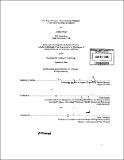| dc.contributor.advisor | Fiona Murray. | en_US |
| dc.contributor.author | Wang, Lisheng, 1977- | en_US |
| dc.contributor.other | Massachusetts Institute of Technology. Technology and Policy Program. | en_US |
| dc.date.accessioned | 2006-03-29T18:29:49Z | |
| dc.date.available | 2006-03-29T18:29:49Z | |
| dc.date.copyright | 2004 | en_US |
| dc.date.issued | 2004 | en_US |
| dc.identifier.uri | http://hdl.handle.net/1721.1/32274 | |
| dc.description | Thesis (S.M.)--Massachusetts Institute of Technology, Engineering Systems Division, Technology and Policy Program, 2004. | en_US |
| dc.description | Includes bibliographical references (p. 89-97). | en_US |
| dc.description.abstract | This thesis reviews the developments in the research of business power and social structure, particularly focusing on the phenomena of "inner circle" and "structural hole" and their underlying theories. Through a close study on its technical and commercial developments as well as its ethical controversies, the American stem cell industry is found to be an interesting area to carry out the power structure research. Increasing political intervention and declining profitability make the American stem cell industry highly analogous to the entire American corporate community in 1970s and early 1980s when business inner circle first emerged. Meanwhile, the American stem cell industry also differs from the social context of a typical inner circle in a number of ways, which means special research strategy is required for the study on stem cell inner circle. Such analogue with slight deviation brings excitement to the power structure research in this highly entrepreneurial yet tightly regulated industry. 12 U.S. stem cell companies that well represent the American stem cell industry are selected to form a sampling for this power structure study. Stem cell inner circle is defined in this thesis as a group of people who are playing critical roles in the stem-cell related scientific, commercial, governmental activities. In search for this inner circle, definitions are given to the stem-cell related scientific, commercial and governmental activities to first identify people who are important individuals in the scientific, commercial and governmental circles respectively. By overlapping those three circles, a group of people in the intersection, termed the "stem cell inner circle", are identified. | en_US |
| dc.description.abstract | (cont.) The formation of such an inner circle is then empiristically explained with the theory of "structural hole", especially the brokerage mechanism, based on the unique academic, commercial and political characteristics of the American stem cell industry. Finally, a number of possible topics for future researches that can be built on this thesis are suggested. | en_US |
| dc.description.statementofresponsibility | by Lisheng Wang. | en_US |
| dc.format.extent | 97 p. | en_US |
| dc.format.extent | 4569007 bytes | |
| dc.format.extent | 4574271 bytes | |
| dc.format.mimetype | application/pdf | |
| dc.format.mimetype | application/pdf | |
| dc.language.iso | eng | en_US |
| dc.publisher | Massachusetts Institute of Technology | en_US |
| dc.rights | M.I.T. theses are protected by copyright. They may be viewed from this source for any purpose, but reproduction or distribution in any format is prohibited without written permission. See provided URL for inquiries about permission. | en_US |
| dc.rights.uri | http://dspace.mit.edu/handle/1721.1/7582 | |
| dc.subject | Technology and Policy Program. | en_US |
| dc.title | The Web of science : power structure research of the American stem cell industry | en_US |
| dc.type | Thesis | en_US |
| dc.description.degree | S.M. | en_US |
| dc.contributor.department | Massachusetts Institute of Technology. Engineering Systems Division | |
| dc.contributor.department | Technology and Policy Program | |
| dc.identifier.oclc | 61311121 | en_US |
